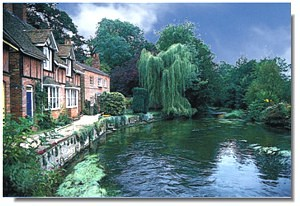 The Village
The Village
Downton is a small, ancient village at the side of the Salisbury Road. People have lived in Downton for over 7,000 years.
Evidence of Iron Age, Roman and Saxon settlements abound here. The
St Laurence Parish Church has elements of Saxon
architecture. Click here for a booklet I prepared on the church and its artifacts. The village, which is just south of
Salisbory and north of Bournmouth, is located in the heart of the New Forest. The New Forest abounds with stunning landscapes
along the River Avon and protected horses graze freely throughout the area. There are many great events held in the area and
it is ideal for a summer getaway. See below for some of the area's attractions.
|
|
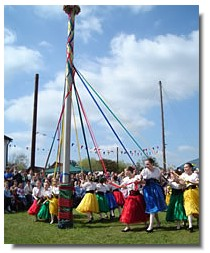 The Cuckoo Fair
The Cuckoo Fair
the Downton fairs were first recorded in 1249 and in 1289 a fair was claimed on the eve, day and morrow of St.
Laurence (9th-11th April). Early fairs died out and in 1676 two annual fairs were granted on 12th April and 21st
September. The annual Downton Cuckoo Fair has been running in its current form for over a quarter of a century and
attracts up to 20,000 people for Maypole, morris dancing and folk entertainment. The fair also features craft
demonstrations, line dancing, street entertainment, music and the Downton Brass Band.
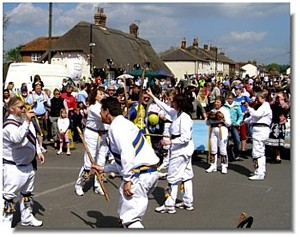
The arrival of the cuckoo was traditionally seen as the onset of good weather and the Downton tradition
of "opening the gate" to let the cuckoo through is the basis of the fair. When the term Cuckoo Fair came to be
used seems to be unknown, as is any possible links with pagan festivities. The Cuckoo Princess only dates from the
revival of the fair in 1980 but there may have been an earlier Cuckoo King.
[SOURCE: DOWNTON OFFICIAL SITE.]
|
Click here for more information on THE CUCKOO FAIR.
Click here for more information on DOWNTON PARISH CHURCH. |
|
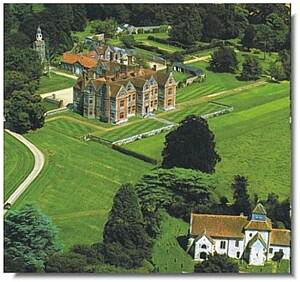 Breamore House
Breamore House
Dating from 1583, this is the magnificent Elizabethan manor house is the home of Sir Edward and Lady HULSE.
Breamore House, which has a working museum, shop and restaurant, is an noted for its fine collection of paintings
Breamore house was completed five years before the Spanish Armada and looks today much as it would have done
to its’ original owners. Breamore House was used as one of the locations for the 2005 film "Pride & Prejudice."
The village of Braemore has a much older history and, though it was recorded in the Doomsday Book, there were settlements in
what is now the parish boundary long before 1066. Today there are many 17th and 18th century cottages remaining in the village.
The Saxon church of St. Mary was built in 980 and is remarkably original for a building of it’s age.
[SOURCE: WIKIPEDIA.] |
Click here for the BREAMORE HOUSE SITE.
Click here for information about BREAMORE VILLAGE.
Click here for information about BREAMORE VILLAGE (Wikepedia). |
|
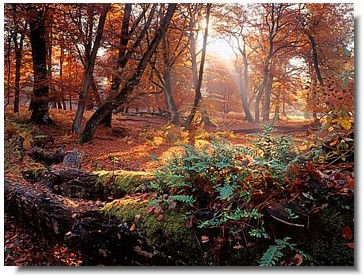 The New Forest
The New Forest
A wonderful area of natural beauty, ideal for walking, riding and enjoying "olde" England accompanied by many
wild horses that still roam free. Like much of England, the New Forest was originally woodland, but parts were
cleared for cultivation from the Stone Age and into the Bronze Age. The poor quality of the soil in the New Forest
meant that the cleared areas turned into heathland "waste." There are around 250 round barrows within its boundaries,
and scattered boiling mounds, and it also includes about 150 scheduled ancient monuments.
[SOURCE: WIKIPEDIA.]
|
Click here for the NEW FOREST TOURISM.
Click here for the NEW FOREST SOCIETY. |
|
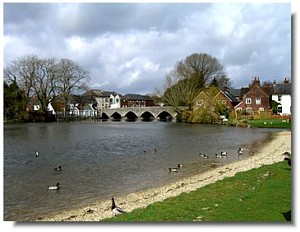 Fordingbridge
Fordingbridge
Fordingbridge is a former market town situated on the River Avon in the west of Hampshire, England, near
the Dorset and Wiltshire borders and on the edge of the New Forest. It just south of the city of Salisbury,
and just north of the seaside resort of Bournemouth. The Avon Valley Path passes through the town. The town
was recorded in the Domesday Book under the name Forde and received its present name when the river was bridged
at the town in 1286 or earlier. The first Great Bridge, built in mediaeval times, is upstream from the ford. The
bridge is a major feature of the town with its seven graceful arches, which can be seen very easily from the town’s
large riverside park where you can walk along the riverbank draped with willows and waterside plants. Not far from the
High Street is the parish church of St. Mary the Virgin. Largely built in 1150 it has some typical Norman
characteristics.There is a Roman villa in the nearby village of Rockbourne, which is open to visitors during the summer.
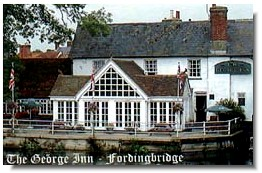 I highly recommend spending an afternoon in The George Inn, which offers great food and drink and fabulous views of the
bridge and the River Avon.
I highly recommend spending an afternoon in The George Inn, which offers great food and drink and fabulous views of the
bridge and the River Avon.
[SOURCE: WIKIPEDIA.]
|
Click here for information about THE GEORGE INN.
Click here for inforamtion on the FORDINGBRIDGE MUSEUM.
Click here for FORDINGBRIDGE (New Forest Online). |
|
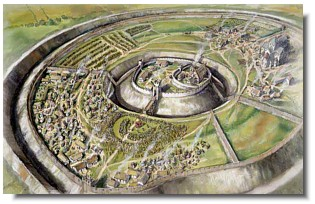 Old Sarum & Salisbury Cathedral
Old Sarum & Salisbury Cathedral
Old Sarum is the site of the earliest settlement of Salisbury, in England. The site contains evidence of human
habitation as early as 3000 BC. Old Sarum is mentioned in some of the earliest records in the country. It sits
on a hill about two miles north of modern Salisbury.
[SOURCE: WIKIPEDIA.]
Click here for OLD SARUM (English Heritage).
Click here for HISTORY OF OLD SARUM (English Heritage).
Click here for more on OLD SARUM (Brit Express). |
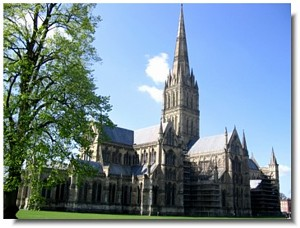
Salisbury, a cathedral city in Wiltshire, England, is located near the edge of Salisbury Plain. It sits at the confluence
of five rivers: the Nadder, Ebble, Wylye and Bourne are tributaries to the Avon, which flows to the south coast and
into the sea at Christchurch, Dorset. Although the current city was not established until 1220, there has been a settlement
in the area since prehistory. There is evidence of Neolithic settlement on the hilltop of Old Sarum, which became a hill
fort in the Iron Age. The first Salisbury Cathedral was built between 1075 and 1092, and a larger building was built on the
same site circa 1120. After a dispute between the clergy and military Old Sarum was abandoned and New Sarum, now known as
Salisbury, was founded in 1220 and a new cathedral was started that year and was completed in only 38 years. It is a
masterpiece of Early English architecture. The spire, which was built later, is the tallest spire in the UK. The cathedral
contains the best preserved of the four surviving copies of the Magna Carta. A large mechanical clock, the oldest surviving
mechanical clock in Britain, was installed in the cathedral in 1386.
[SOURCE: WIKIPEDIA.] |
Click here for VISIT SALISBURY.
Click here for SALISBURY CATHEDRAL. |
|
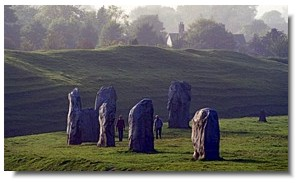 Avebury & Stonehenge
Avebury & Stonehenge
Avebury, which dates from around 2,600-2,500 BC, is a complex of stone circles covering around 28 acres.
Silbury Hill, the Sanctuary on Overton Hill, the West Kennet Long Barrow and the the Uffington Pre-Iron Age Horse
are also closs by.
Click here for more info about AVEBURY (Wikipedia).
Click here for more info about AVEBURY (English Heritage).
Click here for more info about AVEBURY (Stone Pages).
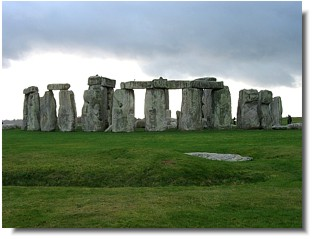
Stonehenge is perhaps the world’s most famous prehistoric monument. It was built in several stages: the first
monument was an early henge monument, built about 5,000 years ago, and the unique stone circle was erected in
the late Neolithic period about 2500 BC. In the early Bronze Age many burial mounds were built nearby.
Today, together with Avebury, Stonehenge forms the heart of a World Heritage Site, with a unique concentration of prehistoric monuments.
[SOURCE: English Heritage.] |
Click here for more info about STONEHENGE (Wikipedia).
Click here for more info about STONEHENGE (Britannica).
Click here for more info about STONEHENGE (English Heritage).
Click here for more info about SILBURY HILL (Wikipedia).
Click here for more info about WEST KENNET LONG BARROW (Wikipedia).
Click here for more info about UFFINGTON WHITE HORSE (Wikipedia).
Click here for more info about CROP CIRCLES (Wikipedia). |
|
 Lymington & the Sea
Lymington & the Sea
On the west side of the Solent, this picturesque harbour town features Georgian and Victorian
architecture, a cobbled quay, antique shops and many other attractions.
Click here for more information about LYMINGTON (Wikipedia).
Click here for LYMINGTON (Visit Hampshire).
Click here for LYMINGTON (The New Forest). |
|
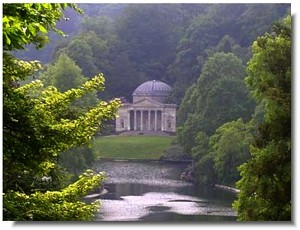 Stourhead & Heale House
Stourhead & Heale House
Stourhead, built in 1720, is world famous for its lakes, gardens, temples and monuments.
Click here for more information about STOURHEAD (Wikipedia).
Click here for STOURHEAD (National Trust).
Click here for STOURHEAD GARDENS (Brit Express).
Heale House is set on eight acres, with lovely gardens, including a Japanese water garden.
Click here for more information on HEALE GARDENS.
Click here for more information on HEALE GARDENS (Brit Express).
|
|
 Shaftesbury's Gold Hill
Shaftesbury's Gold Hill
Located on the edge of a 700-foot plateau, this ancient cobbled street which runs beside the walls of King
Alfred's abbey is the most photographed street in England. I would highly recommend spending an afternoon at the Gold
Hill Museum and Garden. I have spent many happy hours looking through their amazing collection of artifacts.
Click here for more information on SHAFTESBURY'S GOLD HILL.
Click here for information on SHAFTESBURY (Brit Express).
Click here for SHAFTESBURY TOURISM.
Click here for GOLD HILL MUSEUM. |
|

|
|
|
© Media Design, All Rights Reserved.
Site built by

|
|